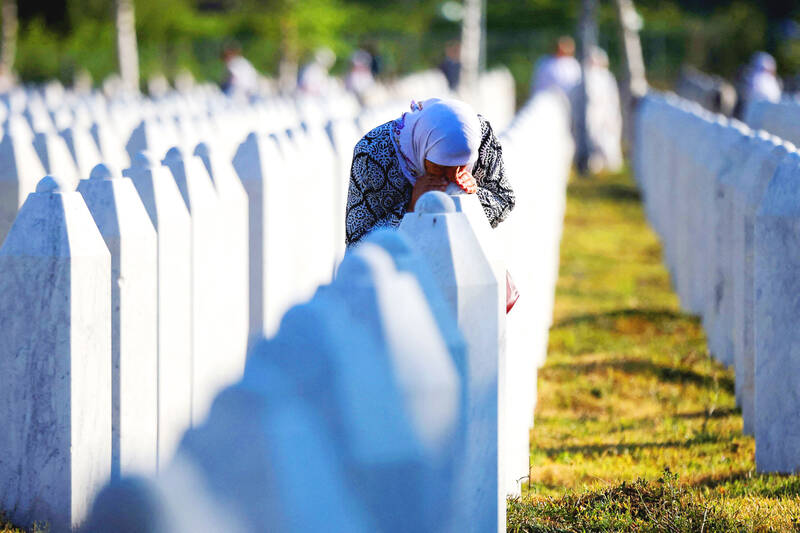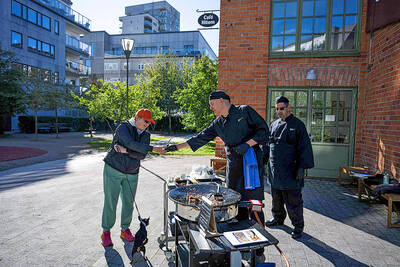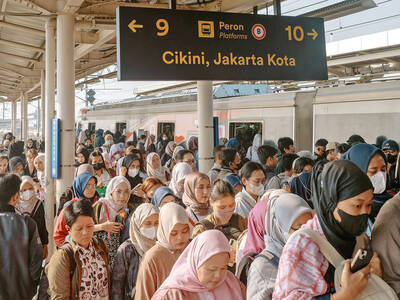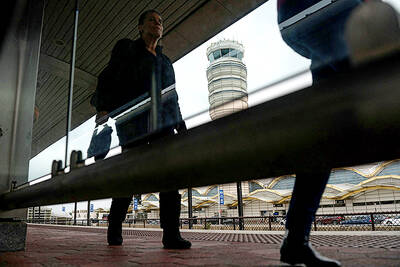Thousands of people gathered in Srebrenica yesterday to commemorate the genocide committed 30 years ago by Bosnian Serb forces, one of Europe’s worst atrocities since World War II.
On the eve of the commemorations, thousands of Srebrenica peace marchers, who have walked more than 100km in memory of the victims and survivors of the massacre, arrived at the Srebrenica-Potocari Memorial Center.
The remains of seven victims of the massacre would be laid to rest during commemorations, marking the bloodiest episode of Bosnia’s inter-ethnic war in the 1990s.

Photo: Reuters
The war broke out after Bosnia declared independence, a move supported by the country’s Muslims and Croats, but rejected by Serbs.
On July 11, 1995, after a siege of more than three months, Bosnian Serb forces captured the eastern town, which was at the time a UN-protected enclave.
They killed 8,000 Muslim men and boys in the following days and buried them in mass graves.
About 100 women were killed in the massacre, 80 of whom remain missing.
So far, about 7,000 victims have been identified and buried, while about 1,000 are still missing.
In a bid to cover up the crime, the Bosnian Serb authorities had the remains removed to secondary mass graves, causing many of the bodies to be shredded by heavy machinery, experts said.
“For 30 years we have carried the pain in our souls,” Mothers of Srebrenica president Munira Subasic said.
Her husband, Hilmo, and 17-year-old son Nermin were killed in the massacre.
“Our children were killed, innocent, in the UN protected zone. Europe and the world watched in silence as our children were killed,” she said.
The seven victims buried yesterday included a 19-year-old man and a 67-year-old woman.
The remains of most of the victims are incomplete and in some cases consist only of one or two bones, experts said.
The families have waited years to bury their loved ones, hoping that more remains would be found.
However, Mevlida Omerovic decided not to wait any longer to bury her husband, Hasib.
He was killed at the age of 33, probably in Petkovci, about 60km north of Srebrenica.
About a thousand people were transported there and locked up in a school before being executed.
It is one of five mass execution sites of the massacre, the only atrocity of Bosnia’s 1992-to-1995 war that was qualified as genocide by international justice institutions.
“Thirty years have passed and I have nothing to wait for anymore,” 55-year-old Omerovic said.
She wants to be able to visit her husband’s grave, even though only his jawbone would be in the coffin.
Nezira Mehmedovic said visiting the graves of her two sons, Sajib and Sinan, killed in the massacre in their early 20s, enables her to feel closer to them.
“I like the most to come here to my sons. I talk to them, I cry, I pray, I kiss them... and for thirty years like that,” she said.
“My heart aches for them constantly,” the 75-year-old woman said, crying. “They say life goes on... But how?”
Bosnian Serb wartime political and military leaders Radovan Karadzic and Ratko Mladic were sentenced to life imprisonment by an international tribunal, notably for the Srebrenica genocide.
However, Serbia and Bosnian Serb leaders continue to deny that the massacre was a genocide.
“The Serbs did not commit genocide in Srebrenica... it did not happen,” Bosnian Serb leader Milorad Dodik said this month.
Last year, an international day of remembrance was established by the UN to mark the Srebrenica genocide, despite protests from Belgrade and Bosnian Serbs.
“July 11 is a day of great sadness and pain,” said Ramiza Gurdic, whose husband, Junuz, and sons, Mehrudin and Mustafa, were killed in the massacre. “But for me, every day is July 11, every night, every morning, when I get up and realize that they are not here.”

READINESS: According to a survey of 2,000 people, 86 percent of Swedes believe the country is worth defending in the event of a military attack Swedes are stocking up on food items in case of war, as more conflict in Europe no longer feels like a distant possibility, and authorities encourage measures to boost readiness. At a civil preparedness fair in southwest Stockholm, 71-year-old Sirkka Petrykowska said that she is taking the prospect of hostilities seriously and preparing as much as she can. “I have bought a camping stove. I have taken a course on preservation in an old-fashioned way, where you can preserve vegetables, meat and fruit that lasts for 30 years without a refrigerator,” Petrykowska said. “I’ve set aside blankets for warmth, I

FRUSTRATIONS: One in seven youths in China and Indonesia are unemployed, and many in the region are stuck in low-productivity jobs, the World Bank said Young people across Asia are struggling to find good jobs, with many stuck in low-productivity work that the World Bank said could strain social stability as frustrations fuel a global wave of youth-led protests. The bank highlighted a persistent gap between younger and more experienced workers across several Asian economies in a regional economic update released yesterday, noting that one in seven young people in China and Indonesia are unemployed. The share of people now vulnerable to falling into poverty is now larger than the middle class in most countries, it said. “The employment rate is generally high, but the young struggle to

ENERGY SHIFT: A report by Ember suggests it is possible for the world to wean off polluting sources of power, such as coal and gas, even as demand for electricity surges Worldwide solar and wind power generation has outpaced electricity demand this year, and for the first time on record, renewable energies combined generated more power than coal, a new analysis said. Global solar generation grew by a record 31 percent in the first half of the year, while wind generation grew 7.7 percent, according to the report by the energy think tank Ember, which was released after midnight yesterday. Solar and wind generation combined grew by more than 400 terawatt hours, which was more than the increase in overall global demand during the same period, it said. The findings suggest it is

IN THE AIR: With no compromise on the budget in sight, more air traffic controllers are calling in sick, which has led to an estimated 13,000 flight delays, the FAA said Concerns over flight delays and missed paychecks due to the US government shutdown escalated on Wednesday, as senators rejected yet another bid to end the standoff. Democrats voted for a sixth time to block a Republican stopgap funding measure to reopen government departments, keeping much of the federal workforce home or working without pay. With the shutdown in its eighth day, lines at airports were expected to grow amid increased absenteeism among security and safety staff at some of the country’s busiest hubs. Air traffic controllers — seen as “essential” public servants — are kept at work during government shutdowns, but higher numbers